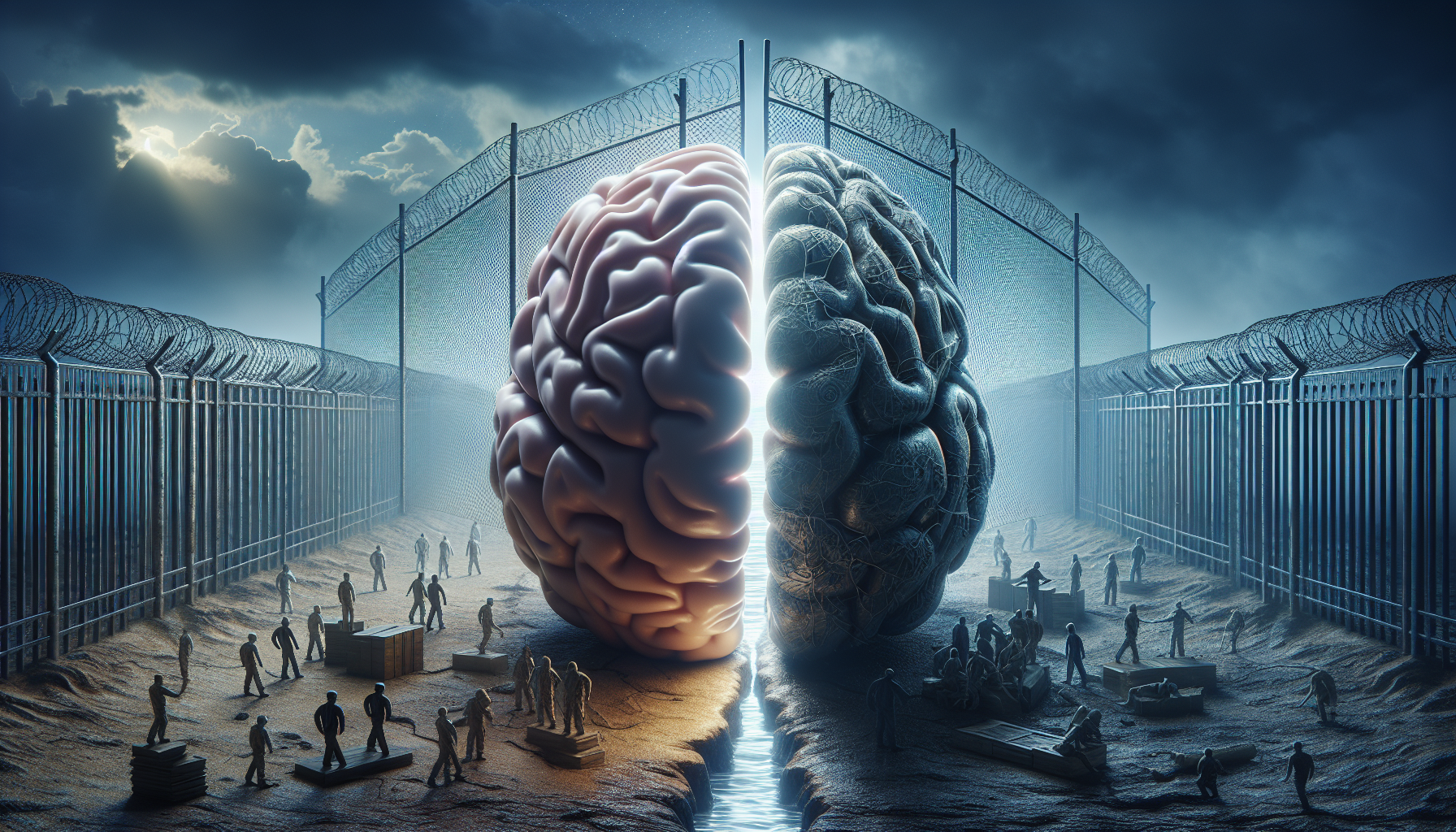In the intricate tapestry of human history, few phenomena have shaped our world as profoundly as the creation of borders. These invisible lines, often drawn with little regard for the landscapes they dissect or the cultures they divide, have been both a source of unity and conflict. But what drives the human impulse to delineate space, to carve out territories and erect boundaries? In this exploration, we delve into the psychology behind border making—a complex interplay of fear, identity, and power—and examine its far-reaching impact on society.
At its core, the act of creating borders is deeply rooted in the human psyche’s need for order and security. From the earliest days of civilization, our ancestors sought to establish boundaries that could protect their communities from perceived external threats. This primal instinct, while evolving over centuries, remains a powerful force in contemporary geopolitics. But borders are more than mere protective barriers; they are also symbols of identity. They define who belongs and who does not, shaping national narratives and fostering a sense of belonging among those within. As we navigate through this article, we will uncover how these psychological underpinnings influence modern border policies and contribute to the global discourse on immigration, nationalism, and conflict.
Beyond their psychological roots, borders wield significant influence over economic and social structures. They dictate the flow of goods and people, often serving as catalysts for economic prosperity or stagnation. The dichotomy of open versus closed borders continues to spark heated debates worldwide, as nations grapple with the challenges of globalization and the quest for economic stability. Furthermore, the impact of borders on social cohesion cannot be overstated. While they can create a sense of unity among inhabitants, they also have the potential to breed division and discord, exacerbating tensions between neighboring states and within multicultural societies. In this article, we will analyze case studies from around the globe, shedding light on how border dynamics shape economies and social fabrics.
Finally, as we traverse the intricate relationship between psychology and borders, we must also consider the future implications of our current trajectory. In an increasingly interconnected world, where technology diminishes distances and cultural exchanges flourish, how will the concept of borders evolve? Will we witness the rise of more inclusive, flexible boundaries, or will the impulse to erect walls persist? By examining emerging trends and visionary ideas, this article aims to offer insights into the potential future of borders and their impact on global society. Join us on this journey as we unravel the complex psychology of border making and its profound influence on the world we live in. 🌍
The Historical Evolution of Border Making
Throughout history, the creation and enforcement of borders have played a pivotal role in shaping societies and international relations. Borders delineate the geographical boundaries of political entities such as countries, states, or cities. However, they are not merely lines on a map; they embody complex psychological, cultural, and socio-economic dimensions that influence human behavior and societal structures. From ancient times to the modern era, the establishment of borders has been driven by the need for security, economic control, cultural identity, and political power. This historical evolution reflects a myriad of psychological motivations that continue to impact how societies function and interact today.
In ancient civilizations, natural boundaries such as rivers, mountains, and deserts often served as borders. These natural barriers provided defense mechanisms against invasions and defined territories for emerging states. The Great Wall of China, for instance, is an iconic example of a man-made boundary designed to protect against nomadic invasions. This early border-making effort highlights the primal psychological desire for safety and security, a theme that resonates throughout human history.
With the rise of empires and nation-states, borders became more politically charged. The Treaty of Westphalia in 1648 is often cited as a turning point in the modern concept of state sovereignty, where borders became symbols of legal and political jurisdiction. The psychological underpinnings of this development include the need for identity and control, as borders began to symbolize not only physical space but also cultural and national identity. The impact of these historical developments continues to influence contemporary border politics, as seen in debates over immigration, national security, and globalization.
The Psychology of Border Perception
The way individuals and societies perceive borders is deeply rooted in psychological constructs. Borders are not just physical demarcations but are also imbued with symbolic meaning. Psychologically, borders can evoke a sense of belonging or exclusion, safety or threat, opportunity or restriction. These perceptions are shaped by cultural narratives, historical experiences, and personal identities, influencing how people relate to borders on both a conscious and subconscious level.
Cultural identity plays a significant role in border perception. For many, borders define a homeland, a place of shared heritage and values. This sense of belonging fosters community cohesion and national pride. However, borders can also evoke feelings of exclusion and otherness, particularly for minority groups or immigrants. The psychological tension between inclusion and exclusion can manifest in social conflicts and policy debates, highlighting the complex interplay between borders and identity.
Another critical psychological aspect is the perception of borders as safety mechanisms. In a world marked by political instability and economic uncertainty, borders can represent a protective barrier against external threats. This perception is often exploited in political rhetoric, where border control is framed as essential for national security. However, this can also lead to xenophobia and isolationism, as fear of the ‘other’ becomes a driving force in public opinion and policy-making.
Comparative Analysis: Borders and Their Societal Impact
| Region | Border Characteristics | Societal Impact |
|---|---|---|
| Europe | Open borders within the Schengen Area | Facilitates free movement and economic integration but faces challenges with immigration control. |
| North America | Controlled borders, particularly between the U.S. and Mexico | Leads to significant economic exchange but also social tensions and immigration debates. |
| Middle East | Highly militarized and contested borders | Results in ongoing conflict, humanitarian crises, and complex geopolitical dynamics. |
In Europe, the Schengen Area exemplifies the benefits and challenges of open borders. While facilitating free movement of people and goods, it also poses security and immigration challenges. The psychological impact on citizens ranges from enhanced European identity to concerns over national sovereignty and cultural dilution.
In contrast, the U.S.-Mexico border illustrates the complexities of controlled borders. The psychological narratives here are shaped by economic interdependence and cultural exchange on one hand, and issues of illegal immigration and border security on the other. This duality influences political discourse and community relations in border regions, emphasizing the multifaceted nature of borders in shaping societal dynamics.
The Impact of Technology on Border Management
Technological advancements have revolutionized border management, introducing new paradigms in how borders are perceived and enforced. From surveillance systems to biometric identification, technology plays a crucial role in modern border security and control. These innovations reflect broader psychological themes of safety, control, and efficiency, reshaping the traditional notions of borders.
Surveillance technologies such as drones and cameras have enhanced border monitoring capabilities, allowing for real-time tracking and threat assessment. While these tools increase security, they also raise ethical concerns about privacy and civil liberties. The psychological impact of surveillance is significant, as it can instill a sense of constant observation and control, affecting individual behavior and social dynamics.
Biometric technologies, including fingerprint and facial recognition, have streamlined the identification process at border checkpoints. This efficiency appeals to psychological desires for safety and order, yet also raises issues of data privacy and discrimination. As borders become more technologically integrated, the psychological implications extend beyond security to questions of identity and autonomy.
To explore more about the impact of technology on border management, you might find the following video insightful:
The Future of Borders – National Geographic
Cultural Narratives and the Shaping of Borders
Cultural narratives play a vital role in shaping and reinforcing borders. These narratives are constructed through historical events, political ideologies, and media representations, influencing public perceptions and policy decisions. Understanding these narratives provides insight into the psychological motivations behind border-making and its societal impact.
Historical events, such as wars or colonialism, often leave lasting impressions on national identities and border perceptions. The psychological scars of conflict can perpetuate divisions, as seen in regions like the Korean Peninsula or Kashmir. These narratives are often perpetuated through education and media, shaping collective memories and attitudes towards borders.
Political ideologies also influence border narratives. Nationalist movements, for example, often emphasize the importance of borders in preserving cultural purity and national sovereignty. This rhetoric can foster unity among supporters but also incite hostility towards perceived outsiders. The psychological allure of nationalism lies in its promise of belonging and identity, which can be both empowering and divisive.
Media representations further shape border narratives by highlighting specific themes and framing public discourse. News coverage of border issues often focuses on security threats or humanitarian crises, reinforcing certain psychological responses such as fear or empathy. This framing can impact public opinion and policy, underscoring the power of media in shaping border perceptions.
- Historical Contexts: Wars, treaties, and colonization as border influences.
- Political Ideologies: Nationalism and sovereignty in border narratives.
- Media Representations: The role of media in framing border issues.
Future Directions: Reimagining Borders in a Globalized World
As globalization continues to blur traditional boundaries, the future of borders remains a critical area of exploration. The psychological, cultural, and technological dimensions of border-making will shape how societies navigate the complexities of an interconnected world. Reimagining borders involves balancing security and openness, identity and integration, autonomy and collaboration.
Globalization challenges traditional notions of borders by facilitating cross-border flows of goods, people, and ideas. This interconnectedness offers opportunities for economic growth and cultural exchange but also presents challenges related to security and identity. The psychological impact of globalization includes both optimism for global cooperation and anxiety over cultural homogenization and economic inequality.
Innovative approaches to border management are essential in addressing these challenges. Multilateral agreements, regional cooperation, and technological solutions can help balance security with openness. For instance, regional trade blocs like the European Union exemplify how borders can be reimagined to promote integration while maintaining sovereignty. These models reflect a shift towards cooperative border governance, emphasizing collaboration over conflict.
The psychological implications of reimagining borders are profound, as they challenge individuals and societies to reconsider concepts of identity, belonging, and security. As borders evolve, so too must our understanding of their role in shaping human behavior and societal structures. The ongoing dialogue between tradition and innovation, autonomy and interdependence, will continue to define the future of borders in an increasingly globalized world.
To delve deeper into this topic, consider watching the following video:
Borders in a Globalized World – TED Talk by Pico Iyer

Conclusion
Conclusion: Unraveling the Mind: The Psychology Behind Border Making and Its Impact on Society
As we reach the culmination of our exploration into the intricate psychology of border making and its profound effects on society, it becomes clear that this topic intertwines deeply with various aspects of human existence. Through the lens of psychology, we have dissected the motives, implications, and outcomes of how borders—be they physical, psychological, or metaphorical—are constructed and the significant roles they play in shaping societies across the globe.
Throughout this article, we examined the historical context of border formation, tracing back to ancient civilizations where borders were first delineated to define territories and assert control. This historical perspective provides a foundation to understand that borders are not just physical demarcations; they are symbols of identity, security, and sometimes division. Understanding the psychology behind these symbols allows us to comprehend why they evoke such strong emotional responses and influence human behavior to a considerable extent.
Central to our discussion was the exploration of the psychological factors that drive border creation. We delved into concepts such as in-group and out-group dynamics, where the need for belonging and identity often leads to the establishment of boundaries. This intrinsic human behavior, though natural, can sometimes foster exclusion and conflict, underscoring the dual nature of borders as both protective and divisive entities.
Moreover, we highlighted the role of cognitive biases in border perception and maintenance. The confirmation bias, for instance, can reinforce pre-existing beliefs about ‘us’ versus ‘them,’ while the anchoring bias may cause individuals to rely heavily on initial information about border conflicts, potentially skewing perception and policy decisions. Recognizing these biases is crucial in developing more inclusive and empathetic approaches to border-related issues.
The article also touched on the societal impact of borders, emphasizing their influence on migration, economy, and cultural exchange. Borders affect migration policies, which in turn shape the demographic and cultural landscapes of nations. The economic implications of border policies can either facilitate trade and growth or lead to isolation and economic stagnation. Thus, the strategic management of borders can significantly dictate the prosperity and cohesion of societies.
Importantly, we addressed the contemporary challenges posed by digital and virtual borders in an increasingly globalized world. The rise of the internet and digital platforms has introduced new dimensions to border discussions, challenging traditional notions of territorial boundaries and sovereignty. This digital evolution demands that we reconsider how borders function and adapt to the rapidly changing socio-political landscape.
In reinforcing the significance of this topic, it is essential to recognize that understanding the psychology behind border making extends beyond academic curiosity—it has practical implications for policymakers, educators, and individuals alike. By fostering awareness and encouraging critical thinking about borders, we can work towards more harmonious coexistence, where borders serve to protect and connect rather than divide.
We invite you, dear reader, to reflect on the insights shared and consider their relevance in your own context. How do borders influence your community, and what steps can be taken to bridge divides and promote understanding? Engaging in open dialogue and sharing diverse perspectives is crucial in addressing the challenges posed by borders in today’s interconnected world.
Your participation is vital—feel free to leave comments below, share this article with your network, or apply the concepts discussed in your personal or professional life. Together, we can contribute to a more inclusive and empathetic society, where the psychology of border making is leveraged for positive change and collective growth. 🌍
For further reading and exploration, consider visiting these resources:
–
– The World Bank – Borders and Development
Thank you for joining us on this insightful journey into the psychology behind border making. Let us continue to unravel the complexities of the mind and its impact on our world.
Toni Santos is a visual storyteller and artisan whose creations celebrate the poetry of the natural world. Through his thoughtful artistic lens, Toni captures the elegance of botanical forms, transforming them into meaningful expressions of symbolism, resilience, and timeless beauty.
His journey is deeply rooted in a passion for flora and the mysteries they carry. From the shape of a petal to the curve of a vine, each design Toni brings to life reflects a deeper narrative — one of growth, transformation, and harmony with nature. Whether crafting symbolic floral jewelry, enchanted botanical illustrations, or seasonal visual studies, Toni’s work evokes the quiet magic found in Earth’s most delicate details.
With a background in handcrafted artistry and visual design, Toni blends technique with intention. His creations do more than decorate — they speak, often inspired by ancient meanings behind flowers, the cycles of the seasons, and the invisible bonds between nature and spirit.
As the creative voice behind Vizovex, Toni shares this botanical journey with the world, offering curated stories, handcrafted collections, and thoughtful articles that help others reconnect with nature’s symbolism and artistic essence.
His work is a tribute to:
The quiet power of flowers and their messages
The art of visual symbolism in everyday life
The beauty of slowing down to see what’s hidden in plain sight
Whether you’re an artist, a nature lover, or someone drawn to the deeper meanings behind the natural world, Toni welcomes you to explore a space where aesthetics meet soul — one petal, one story, one creation at a time.





